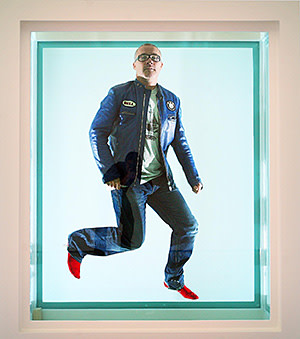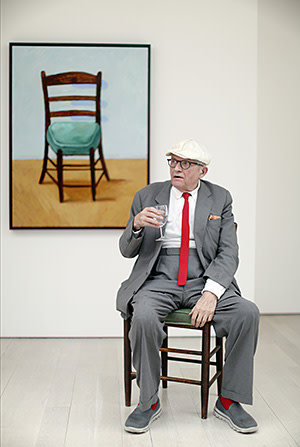Old Masters enjoy revival among collectors
Roula Khalaf, Editor of the FT, selects her favourite stories in this weekly newsletter.
The Old Masters are being seen in a new light. Increasing numbers of collectors of contemporary and modern art are broadening horizons, diversifying collections and buying art from previous centuries. Beautiful Old Master paintings, drawings and sculptures can be had for a fraction of the prices so often paid for more recent works.
Quite why it has taken some collectors so long to realise that is hard to fathom. Art historians and dealers have long looked aghast at the prices paid for contemporary artists barely out of art school, compared with Old Masters, who have track records in standing the test of time.
Andreas Pampoulides, director of fine art at Coll & Cortés gallery, a leading Old Masters dealer in London and Madrid, says the inequality between old and new is “a bit depressing”. For less than £15,000, he observes, “you can buy a really fun Spanish Colonial painting from the 17th or 18th century”, but £15,000 won’t get you very much in the contemporary world.
Referring to Carl Andre’s 1966 sculpture “Equivalent VIII” — a pile of bricks that remains controversial — he adds: “That’s part of what we’re seeing — people just can’t believe that you can buy something that’s 300 years old for the same price as a pile of stacked-up bricks.”
Adam Prideaux of Hallett Independent Art Insurance, a specialist broker, senses the shift in interest among some contemporary collectors. “The more traditional markets are seen as undervalued,” he says. His business partner, Louise Hallett, is astonished by the disparity in prices between, for example, antiquities and contemporary art. “It’s absolutely ludicrous that you can still get a piece of 2,500-year-old Roman glass in immaculate condition for under £1,000,” she says. That sort of money will barely stretch to a work by some art school students.
You only have to compare the prices achieved by Damien Hirst — such as the £10.3m paid for “The Golden Calf”, a bull in formaldehyde, at Sotheby’s in 2008 — with an Old Master jewel such as Bernardo Bellotto’s ravishing 1730s painting “Venice, a View of the Grand Canal”, which has an upper estimate of just £3.5m in a sale at Sotheby’s in London next month. The latter certainly looks like a bargain.

Stephen Ongpin, a London-based dealer in 15th to 21st-century drawings and watercolours, spans both new and old art — seen as “two very different areas with two very different clienteles”, he observes. But he is now encountering contemporary collectors who are starting to look back in time. “It is definitely a trend,” he says.
Just as artists themselves often take inspiration from older art, it is “rewarding” when a collector does the same thing, Ongpin says. “I’ve had contemporary drawings — for example, a large drawing by Jenny Saville that was itself based on a drawing by Leonardo da Vinci. I had a lot of responses to that drawing from Old Master collectors as well as contemporary collectors.”
The Saville drawing, “Mother and Children”, is a depiction in charcoal of the pregnant artist holding two squirming babies. It is inspired by da Vinci’s masterpiece “The Virgin and Child with Saint Anne and Saint John the Baptist”, which hangs in London’s National Gallery.

Fabrizio Moretti, president of Moretti Fine Art, which has galleries in Florence, London and New York, says one of the main reasons people are looking to Old Masters is the financial one. Another factor, he adds, is that “when you buy an Old Master, you are buying history — that attracts people”.
That thought is echoed by Wang Wei, who, with her billionaire financier husband, Liu Yiqian, has put together one of China’s largest private collections, ranging from antiquities to contemporary art. “There is a resurgence of collectors who have these ambitions,” she says. “After all, art history is at a crossroads, and avant-garde and bold contemporary art cannot be made without [a] study of the past.”
Noting that Old Masters have stood the test of time, Ongpin says: “It’s hard to know really [how] Hirst will be regarded in 50 years’ time. I think you’re safe with [Lucian] Freud, [David] Hockney and [Francis] Bacon. But Tracey Emin? Who knows?”
Others go further, predicting the contemporary art bubble will soon burst. In 2012, Julian Spalding, former director of some of Britain’s foremost public galleries, including Glasgow’s Gallery of Modern Art, ridiculed Hirst and other exponents of what he called “con art” — a play on the term “conceptual art”, the so-called art of ideas. He likened this bubble to the sub-prime mortgage crisis, warning it would burst when collectors eventually realised how “seriously worthless” such art was. He urged collectors to sell while they could.
Such attacks may be taking their toll on investment choices, it seems. Spencer Ewen, managing director of Seymours, a firm of art advisers, says some of the adverse criticism of contemporary art in the media has, over time, made some collectors “a little wary”, adding: “Most collectors are intelligent people — they read and observe. There is lot of good and sound, successful contemporary art, but the problem, even for people within the industry, is to buy what has long-term substance and gravitas.

“People talk about art with friends and people in the industry, [asking] ‘where is the substance in contemporary art and how do you find it?’ There are numerous stories, apocryphal or otherwise, that scare laymen to the market. Everybody’s heard of the emperor’s new clothes story. Our job is to identify true substance and quality in the contemporary sector.”
Collector Jeffrey Horvitz says his “favourite art” was created in the 20th and 21st centuries but, since the 1980s, he has built up an extraordinary collection of some 1,400 Old Master drawings, by artists such as François Boucher. Such is their quality that he regularly lends to museums.
He too is repeatedly astonished by the disparity in prices. Referring to Mark Rothko, the American 20th-century abstract artist, and Canaletto, the 18th-century Venetian master, he says: “Why would a Rothko be worth 10 times a Canaletto? It doesn’t make a lot of sense.”
Horvitz also mentions Alberto Giacometti, the 20th-century master whose “L’Homme qui marche I” (Walking Man I) sold at Sotheby’s in London in 2010 for a record £65m, and Nicolas Poussin, the 17th-century French master. “Why would a Giacometti be worth 10 times a major Poussin?” he asks. “In the French and Italian fields, you can buy remarkably beautiful drawings — as long as you’re not worried about the name — for under $1,000. But you have to be looking at it as a work of art, as opposed to thinking about telling your friends how much you spent.”
Horvitz suggests some collectors of contemporary and modern art have bought recognisable works as “a way of showing your culture and your social status after you become rich”.
It is not the physical appearance or the style of the art so much as what is “fashionable” now, he observes. “If you really want to be chic, cool, in-the-know, the best way to do that is with contemporary art, even better than modern art,” he says. “It’s no good if your friends don’t recognise what it is. It would be crass to tell your friends, ‘I just spent $60m on a Rothko.’ But Rothkos are readily identifiable, so anyone who walks in may not know you spent $60m, but they’ll know you spent tens of millions.”
A major art fair, Masterpiece, is being staged in London until July 1. Its chief executive is Nazy Vassegh, who was managing director of Impressionist and modern art at Sotheby’s before setting up an independent art advisory firm. She too detects a broadening of horizons among collectors.
Masterpiece covers 4,000 years of the history of art and the fair has, over the past five years, actively encouraged cross-collecting by juxtaposing old and new and different categories. “A visitor might walk past stands of 20th-century design, antiquities, modern, decorative arts, porcelain and so on. That’s our way of very intentionally exposing collectors to different genres and periods,” says Vassegh.
Contrasting the Masterpiece approach with that of the annual European Fine Art Fair in Maastricht, the Netherlands, where the space is divided up into Old Masters, modern and other zones, she adds: “In the contemporary art market, you’ve got the top 20 artists reaching dizzying heights and making the headlines. People are seeing Old Masters and antiquities, and are looking at other forms of collecting. These forms of more traditional art have had the longevity through time, establishing their place. A lot of [today’s] artists don’t have that proven track record. What is crucial is that you do your due diligence and your research carefully.”
Coll & Cortés, Ongpin, and Moretti are among connoisseur-dealers that will be showing at another important fair, London Art Week 2015, which runs from July 3 to July 10. Collectors and curators will be among those descending on Mayfair and St James’s in central London where more than 40 leading galleries and three auction houses will show paintings, drawings and sculptures from antiquity to the 20th century.
The Colnaghi gallery will be offering an important rediscovery — “The Sayer Family of Richmond 1781”, an exceptional painting by Johan Zoffany, a favoured painter of King George III.
Last year’s London Art Week attracted thousands of visitors from around the world, including representatives from international museums. Whether they are joined by collectors of contemporary and modern art this time remains to be seen.
Masterpiece 2015: masterpiecefair.com
London Art Week 2015: londonartweek.co.uk
Comments